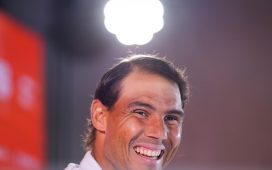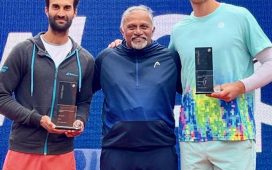Back in the spring of 2019, Naomi Osaka was coming off consecutive grand slam titles and digesting her newfound presence as a leading name in world sport when the subject shifted to the seemingly imminent 2020 Olympics. In order to represent Japan there, the then 21 year-old Osaka would have to attempt to gain full Japanese citizenship after her 22nd birthday.
The decision, which received prominent attention, was widely framed as a difficult choice between being American or Japanese, speculation that soon reached her in a press conference at the Miami Open. Despite recent discourse, Osaka rarely exhibits her frustration in front of the media. This time, however, it was clear: “I made comments about it already so if you want to read those comments …” she responded curtly. “I’m kind of over repeating myself all the time, so … I mean, I’m not trying to be rude.”
The frustration was more than understandable. Considering the way Osaka speaks about her heritage, there has been no choice to make for a long time. She was born in Japan. She is Japanese as well as she is Haitian. She made that choice to represent Japan when she was 14 and she has never wavered. But throughout her time in the spotlight, whether explicitly or suggestively, her heritage has been questioned.
Despite how easily she represents both her Haitian and Japanese heritage, so often ignorance and confusion has reflected back from all areas. While numerous Americans claim she does not represent Haiti enough to their specifications. After her outspoken support for Black Lives Matter, Osaka received more than a few racist pile-ons on Twitter from some Japanese users who would pointedly refer to her as African American, which she is not.
There was little surprise when Osaka was revealed as the face of an early Tokyo 2020 commercial last February and it is obviously significant. The most prominent Japanese athlete is mixed race and offers significant representation for a growing population of multicultural Japanese people who have been marginalised for a long time. And now she has returned home.
All that alone is a heavy weight for any athlete to bear before their home Olympic Games, but recent events have only accentuated it. Osaka has not competed since the first round of the French Open after her surprise announcement not to conduct press conferences there exploded into the news story of the moment and led Osaka to withdraw from the event for mental health reasons.
After her initial silence, Osaka has since said her piece in an essay in Time Magazine, and she arrived back in Japan where she has been practising for a number of days. Re-entering the tour in her biggest tournament of the year seems like a daunting task but if anyone from the current generation is equipped to deal with this weight, Osaka on a hard court seems a healthy bet. She has had numerous moments of vulnerability throughout her young career, including in this current period, but at her core she is extremely tough, which has been reflected clearly in levels of discipline and fortitude exhibited in all of her grand slam title runs.

Osaka has also already mastered the art of dropping in and producing her best tennis even without significant match fitness behind her back. Before the clay season, Osaka had only played five tournaments between the tour restart in July and March, picking and choosing her events as if she is already an ageing, part-time player. Despite withdrawing from two of them, she won two major titles in that irregular run of events, doubling her total haul to four.
The question though, after essentially missing two slams, is exactly what frame of mind she is in and how ready she is to put everything on the line again. Those are queries that cannot be answered until she is back on the court in the Ariake Coliseum, furiously striking forehands once more.
As Osaka re-enters the fold in Tokyo, she is certainly not returning to the field bursting at the seams with quality. While Novak Djokovic continues his chase for the golden slam and Ashleigh Barty is keen for her supremacy to endure in Olympic competition, the withdrawals have piled up. In the men’s field, half of the top 10 will be absent while the women’s draw has also taken a number of withdrawals, with many players prioritising tournaments that offer points and prize money over an Olympic adventure.
Sign up for our Tokyo 2020 briefing with all the news, views and previews for the Olympic and Paralympic Games.
There are fair reasons for so many absences. Tennis players have been travelling from bubble to bubble for a year and it is fine that some are unmoved by the prospect of even stricter restrictions in Tokyo. But every withdrawal erodes the importance of tennis in the Olympics and this tournament should be a tipping point for the sport’s relationship with the competition. Unless all of the governing bodies are prepared to make it attractive for all, with points and a less congested schedule each year, it feels like a wasted opportunity at best and a pointless endeavour at worst.
While there have been some great Olympic moments, from separate stories of Andy Murray and Del Potro in Rio to London 2012 at the All England Club three weeks after Wimbledon, these issues are not specific to Tokyo. Many players’ interest in Olympic tennis is contingent on location, conditions and convenience. Such attitudes may only grow in the years to come.








